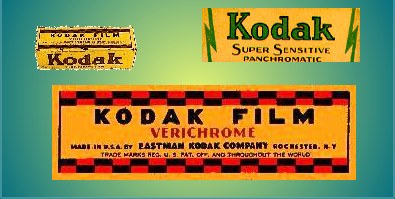
History of Rolled Film
Kodak Roll Films Starting with 101
It first became necessary to specify which Kodak roll film was required with the introduction of the No. 2 Kodak camera in 1889. As different models and sizes of cameras were introduced, the film boxes were marked with the names of the cameras that the roll would fit.
By 1908, this system had become difficult to use for ordering film. It was now necessary to specify the image size and the camera the film was to be used in, as not all films for the same size pictures could be used interchangeably. To simplify this system, it was decided that the daylight-loading roll films on flanged spools would be numbered in the order of introduction, starting with the first Kodak film of this type introduced with the No. 2 Bullet camera in 1895 as number 101.
This system was gradually phased in as new film boxes and camera instruction manuals were printed, but the numbers did not appear in Kodak price lists until 1913. By this time, numbers 101 through 129 were used. Numbers 106 through 114 were used for films spooled for Cartridge Roll Holders, which allowed roll film to be used with cameras designed to use glass plates. In 1916 one more number in this series was added: No. 130 for pictures 2-7/8 by 4-7/8 made with No. 2C Kodak cameras.
Some Kodak and Brownie folding cameras made from 1914 to the 1930's have a little door on the back which is marked "use Autographic film A-(number)". A-116 film, for example, was for the same size pictures as 116 film but instead of red and black duplex paper, the film was wound with a sheet of carbon paper and thin red paper. This film used in an Autographic Kodak camera allowed a brief message to be written on the film in the space between the pictures. Pressure of a stylus on the backing paper transferred the carbon to the red paper and light passing through these lines in the carbon paper would photograph the message onto the film.
When 620 and 616 films were designed in 1931, considerable thought was given to the numbering. These films were for the same picture sizes as 120 and 116 but the spool diameters were smaller to allow them into thinner cameras. The "6" was to indicate the number of pictures per roll but by the time this product had reached the market, the decision had been made to increase the number of pictures on this size and on sizes 120 and 116 to eight exposures so the "6" became meaningless.
In 1935, the Kodak Bantam cameras were introduced. The film for these cameras provided for eight exposures 28 x 40 mm, and the number 828 was chosen for this films.
Size 220 was introduced in 1965, and is twice the length of 120 size film -- although it uses the same spool. This film has only a paper leader and trailer for light protection and no paper behind the film. It is used with professional cameras which advance the film automatically instead of using a window on the back of the camera to position the film.

